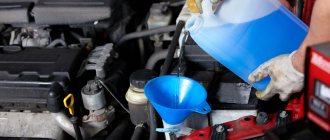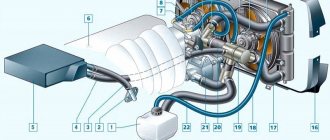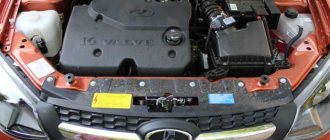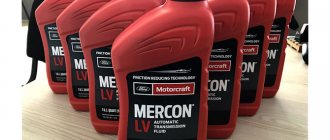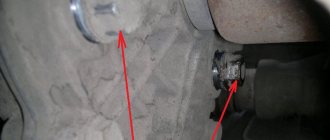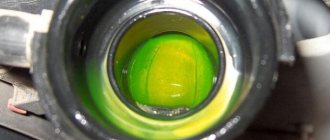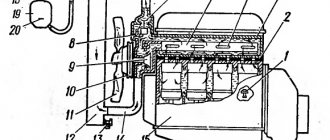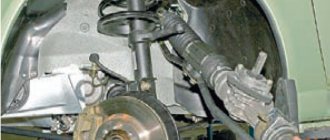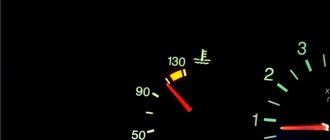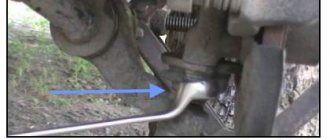How much antifreeze is needed for viburnum
One of the mandatory preventive measures - replacing antifreeze on Kalina - despite its availability, often baffles novice car enthusiasts.
Meanwhile, the process is quite simple and requires minimal familiarity with technology. It’s quite troublesome to take your car to a service center for such a banal procedure, wasting time and money. It’s easier to read the instructions below and complete the task yourself, receiving legitimate satisfaction from the work done with your own hands.
Need for replacement
Antifreeze on Kalina is replaced, in accordance with the manufacturer’s recommendations, either after two years of operation or after 60,000 km. mileage
. The occurrence of one of these conditions indicates the need for replacement.
For the action you need to prepare a tool. The list is quite simple:
- figured (phillips) screwdriver;
- open-end wrench or socket 13;
- head at 17;
- collar
Replacing antifreeze
All further manipulations are carried out when the car is placed on a level surface
(some experts stipulate that a slight tilt towards the rear is possible, but it is better to achieve an ideal horizontal position). The engine must cool completely - this is necessary both for the “purity of the experiment” and from a safety point of view.
First you need to remove (and maybe not completely) the ignition module to gain access to the drain plug. There is a danger that the drained coolant will fall on the module coil and damage it.
Having unscrewed the three fastening bolts (the last one can only be loosened), we move the coil to the maximum allowable distance and continue working.
It is necessary to drain the old antifreeze, for which it is enough to unscrew the plug
. But before that, you need to ensure that you have a sufficiently capacious container that will need to be placed under the drain. This can be any container of sufficient volume (some even manage to use a plastic bottle with a cut off neck, which is periodically emptied by plugging the drain with a finger - while changing containers).
Then in a similar way
drain the antifreeze from the radiator - for this purpose the latter has a special plug (located in the right corner - in the direction of travel).
After making sure that all the antifreeze has been drained, use a rag to remove all traces of it on the engine and crankcase protection. All plugs are installed in their places.
- It is necessary to ensure complete release of air from the system - the formation of “plugs” sharply reduces the efficiency of the entire structure. To do this, you need to remove the throttle hose by unscrewing the clamp on it;
- Only after this do we begin pouring antifreeze. We pour in a thin stream until we can detect a certain amount of liquid pouring out of the hose;
- Then we attach the hose in place and pour antifreeze into the tank, controlling its level in accordance with the mark. It is recommended not to strive to achieve the risk designated as “maximum” - it is enough to bring the level closer to it;
- After tightening the plug and installing the ignition module in place, we start the engine. Evidence that everything was done correctly will be the fan operating and pumping hot air into the cabin (naturally, the heater must be turned on). If not, we take measures to remove the air lock. Everything was thoroughly analyzed in the article);
- Then you need to turn off the engine and, after waiting for it to cool completely, check the coolant level again. If necessary, add antifreeze to the tank.
As you can see, replacing antifreeze on Kalina is a fairly simple process, accessible even to an amateur.
According to the maintenance regulations for Lada cars, the coolant (antifreeze, antifreeze) should be changed every 75 thousand km. mileage or after 5 years, whichever comes first. At this moment, it is important to choose the right liquid correctly, then there will be no comments about it for the same amount of time.
Instructions for replacing Coolant
On Kalinas with 8 and 16 valve engines, the coolant replacement is different. You can drain the old fluid from the radiator without any problems, but from the block on a 16-valve engine it is more difficult. You will have to unscrew the starter.
Replacing antifreeze on an 8-valve Lada Kalina engine
So, we relieve the pressure in the system by unscrewing the cap of the expansion tank. Then remove the engine protection to get to the drain plug.
We take a container with a volume of 6-8 liters and place it under the drain hole located at the bottom right of the radiator. To make the pressure weaker, screw the expansion tank cap back on.
Unscrew the drain plug on the radiator and allow the liquid to completely drain from the radiator.
Draining fluid from the cylinder block on an 8 valve engine
On an 8-valve engine with a traction drive gearbox, draining the old coolant is quite simple. The drain plug is located under the ignition coil.
Using the “13” socket, unscrew the drain plug, place the container and drain the liquid.
Drain the liquid from the cylinder block on a 16 valve engine
To get to the drain plug you will need to remove the starter. If you do not remove the starter, but unscrew the plug and drain the liquid, it will flow directly onto it, which can lead to failure.
Disconnect the wiring block from the traction relay on the starter. Remove the protective cap from the positive wire, and using a 13 mm wrench, unscrew the nut and remove the wire.
Next, use a 13mm wrench to unscrew the three starter mounting bolts and remove it.
Now all that remains is to unscrew the drain plug and drain the coolant from the cylinder block.
After the liquid has been drained from the block, tighten the drain plug with a force of 25–30 Nm. We also tighten the radiator cap and fill the coolant through the expansion flank until it is full.
We start moving and begin to put pressure on all the pipes, thereby stimulating a better passage of antifreeze or antifreeze and filling the entire system. Do not forget to monitor the liquid level in the barrel, which should be between Min and Max.
What antifreeze does AvtoVAZ recommend?
For all VAZ engines (Lada Granta, Kalina, Priora, Niva 4x4), the manufacturer’s recommendations are the same (data from books on the operation, maintenance and repair of Lada cars):
- Antifreeze G-48;
- Cool Steam Standard;
- Cool Steam Premium;
- TS-Felix;
- Felix Carbox;
- SINTEC (for example, “Antifreeze SINTEC” TU 2422-047-51140047-2007);
- Long Life;
- G-Energy Antefreexe.
For K4M and K7M power units that are installed on Lada Largus, the manufacturer recommends GLACOEL RX antifreeze (type D). For Lada Vesta and XRAY, it is recommended to use Type D antifreeze based on a mixture of water and ethylene glycol.
AvtoVAZ's response
: coolant in the VAZ 21179 engine cooling system - Antifreeze Sintec LUX G12 (Sintec ANTIFREEZLUX G12).
Coolstream NRC in yellow is also used.
How to drain antifreeze on Lada Kalina. All the subtleties
The coolant in the cooling system of Lada Kalina with 8 and 16 valve engines must be drained before it reaches the wear limit. Replacing antifreeze (Antifreeze) on Kalina is carried out during seasonal vehicle maintenance work, but can be carried out not only after a certain mileage, but also when signs of fluid wear appear. How to replace antifreeze on a Lada Kalina, when to change the fluid and which one is best to fill, we will figure it out together.
Is it possible to mix antifreeze?
Is it possible to mix antifreeze from different manufacturers? The operating manual for the Lada car states: “The use of mixtures of coolants of different brands is not allowed.”
Is it possible to mix antifreeze of different colors, but from the same manufacturer? There is no definite answer, because... Some manufacturers color the coolant “to taste,” while others add color based on the chemical composition or additives. According to statistics, about 85% of motorists do not mix antifreeze of different colors. At the same time, 64% believe that if you mix antifreeze of different colors, nothing bad will happen. You can view the survey and take part in it here.
The book on operation, maintenance and repair of the Lada Vesta car states:
Which company is better
“Behind the Wheel” tested coolants in November 2021. Test results:
In the survey below we provide recommendations for choosing a coolant manufacturer. We share tips in the comments. Let us remind you that the process of replacing antifreeze on Lada cars is described in this article.
Antifreeze replacement in domestic Lada Kalina cars is carried out every 5 years, or after 75,000 km. This task can be completed ahead of schedule when the color of the coolant changes, the radiator is repaired, there is a leak in the system, as well as when other work is performed in the engine cooling system.
Which antifreeze is better and how much to fill in Lada Kalina?
To completely replace antifreeze in a Kalina/Kalina 2 car, you will need 7.8 liters of coolant. At the factory, the manufacturer pours a red composition of the Felix type. To carry out the work, you need to purchase a 10-liter canister of antifreeze or two small containers of 5 liters each.
If the manufacturer filled it with red coolant, then it is not advisable to change it to a composition of another color. Alternatively, the following products can be used:
- SINTEC Luxury G-12 is a red antifreeze, sold in a 10 liter container.
- NIAGARA G12, red, 10 l.
- FELIX Carbox-40. Color - red, 10 l.
- Arctic Circle G12 and others.
All of the above compounds have shown their best performance, so they can be used in Lada Kalina cars.
Replacing Kalina coolant
Replacing antifreeze on Kalina occurs in several stages:
- drain the antifreeze.
- fill in new antifreeze.
- Remove air from the engine cooling system.
Place a container under the drain hole (in the lower part of the right radiator tank) with a volume of at least 6 liters.
- Unscrew the radiator drain plug by hand. Drain the antifreeze into a container. When draining the liquid, unscrew the cap of the expansion tank.
- The drain plug has a rubber O-ring. To drain the coolant from the engine cooling jacket, place a container under the drain hole located on the front side of the cylinder block, closer to the clutch housing.
- Unscrew the drain plug of the cylinder block using a 13mm wrench. Drain the antifreeze from the system.
We tighten the drain plugs of the radiator and cylinder block. We pour clean coolant (5-6 l) into the engine cooling system through the expansion tank.
With the engine running, vigorously compress all the hoses of the cooling system several times in turn, this will help the antifreeze fill the system and expel air from it. As the coolant level in the expansion tank drops, bring it to normal and screw on the tank cap. When the engine warms up, the outlet (lower) radiator hose should be cold for some time, and then quickly heat up, which will indicate the beginning of fluid circulation in a large circle. After waiting for the cooling system fan to turn on, stop the engine. If the fluid level in the expansion tank is constantly decreasing, then there is most likely a leak in the cooling system. In this case, it is necessary to check the tightness of the cooling system and eliminate the malfunction (see “Cooling system”).
Keywords:
xn—-8sbabr6ahc3e.xn--p1ai
How to replace antifreeze on Lada Kalina 8 valves yourself?
Antifreeze or coolant is designed to cool all engine elements as a whole, namely the cylinder block, crankshaft and camshafts and, of course, other elements that belong to the cooling system. However, over time, antifreeze becomes unusable, gradually losing its properties, causing the engine to overheat prematurely and often, which can lead to its complete failure.
In the video, replacing antifreeze with flushing the cooling system on a Lada Kalina:
Replacing coolant on Kalina
Welcome! Coolant - thanks to it, the cooling system cools the entire car engine, and this includes the crankshaft itself, as well as the camshaft, cylinder block and other parts that directly relate to the car engine cooling system, but over time the liquid itself that is poured into the system comes becomes unusable and thereby loses its properties, and there are quite a few properties in it, that is, the properties include essentially all the additives that are mixed with each other and a coolant is obtained, these additives have their own validity period, after which they begin to act very poorly and therefore the car begins to overheat much more often, and due to severe overheating, as you already know, the engine can become unusable in a very short time.
Note! In order to change the fluid in the system, you will need to stock up on: A repair kit, in which you will have spanners, hex keys, as well as wrenches and screwdrivers; in addition, we recommend that you take a clean rag with you, which you will quickly use Clean up traces of spilled liquid on yourself and on the car engine!
- Coolant replacement
- Additional video clip
When should you change the coolant? Someone says that it needs to be changed strictly according to the regulations, someone says it can be changed later, who should we believe here? In fact, some people change the fluid immediately after filling it, have you guessed what this is connected with? Recently, as before, a lot of fakes have been produced for auto parts, and the liquid that cools the engine of a car also applies here, so when choosing a new liquid, be extremely careful and do not go to the store as if you were going there for bread. (If you want to find out how you can recognize whether a liquid is fake or not, then read the article written just for this reason, and it’s called: “Detailed information about Antifreeze and Antifreeze”)
Well, we figured out the purchase of the fluid, but the timing of its replacement is still not known to you (Because we haven’t talked about them yet), so if you follow the factory’s recommendation, the fluid needs to be changed every 75 thousand km or after 3 years have passed from the moment you fill the fluid, but this is a deadline; if possible, we recommend that you change the fluid a little more often (we’ll talk about this a little later), if you don’t change the fluid to a new one on time, then in addition to the fact that the car will constantly heat up, additives will also no longer have any effect, and thanks to additives alone, the cooling system is protected from premature corrosion and other unfavorable things.
Note! So, when do you need to change the fluid, you wonder, well, firstly, it is recommended to change it either according to the factory’s recommendation, or according to how the fluid looks, that is, first you will need to unscrew the cap on the expansion tank (the tank is indicated by an arrow), when the cap is not there, look into the tank and if the liquid in the tank changes its color to another (rust color, or red-brown color), then this means that it has become unusable and needs to be replaced, in addition, if an oil film has formed on the surface of the liquid, then the liquid also needs in replacement!
Replacing antifreeze on Lada Kalina
This is what a used one looks like. Antifreeze, very tired
The entire cooling system of the Lada Kalina engine contains 7.6-7.8 liters of antifreeze, and according to official instructions it should be changed every 60,000 kilometers or five years of operation, whichever comes first.
Possible option for replacing standard antifreeze
Lada Kalina cars are filled with Felix Carbox 40 antifreeze, red, from the factory. Therefore, it is up to you to decide what kind of antifreeze to fill in during a complete replacement, the main thing is that your desires coincide with the temperature range in which the car is operated.
Tool for the job
In order to carry out all the work, we will need the following:
- New antifreeze (coolant) in the amount of 8 liters.
- Crosshead screwdriver.
- The key is "13".
- Socket head for “13” and “17” with ratchet.
- Container for draining waste liquid.
- Rags.
Step-by-step process for draining antifreeze
Before you begin work on replacing the fluid, you must place the car on a flat surface or on a slight slope, provided that the front part is higher than the rear. Also take into account the fact that the machine’s engine must be cold to prevent the possibility of getting burned during operation, so it is best to carry out such work in the morning, after the machine has cooled down overnight.
- The first step when starting work is to remove the cap from the expansion tank.
On a cold engine there will be no pressure under the cap.
To unscrew this plug, you will need a key set to “13”.
To avoid stripping the thread, unscrew the plug carefully.
The process of filling new antifreeze
When all the plugs are tightened, you can begin the operation of filling in new coolant.
- First of all, loosen the clamp and take out the throttle hose. This is necessary so that during replacement, excess air escapes through this hose.
- Next, fill in antifreeze until it flows out of the disconnected hose, or until the liquid level remains unchanged in the expansion tank.
Do-it-yourself coolant replacement
- To drain the coolant from the Lada Kalina you will need to remove the ignition module. Cover the generator with a plastic bag and place the prepared container under the crankcase protection on the right side near the wheel. Now find the radiator cap in the lower left corner and unscrew it. Be careful as the radiator fins are sharp and can cut. The liquid will pour out with great pressure. Move the container and unscrew the plug on the engine.
- Now the cooling system needs to be flushed. If you purchased a special cleaning agent, carefully read the instructions. If you decide to rinse with water, then proceed as follows. To begin, tighten all the plugs, replace the ignition module and return the electrical wires. Fill the expansion tank with distilled water. To ensure that the maximum amount of it fits into the system, squeeze the upper pipe that goes to the radiator with your hand. Start the car and warm up the engine thoroughly. Its temperature should be at least 95 degrees Celsius, because at this value the thermostat opens and the liquid begins to move in a large circle. Turn off the car and wait for the engine to cool down, this will take approximately 10-15 minutes. Next, carry out all the operations to remove the ignition module and drain the liquid, as described above. To further clean the system, you can attach a garden hose to the tank and wash away any remaining dirt under water pressure.
- Also, do not forget about flushing the expansion tank, it also accumulates a sufficient amount of unnecessary deposits. To do this, the steam exhaust pipe from the radiator and the main pipe are removed, as well as the mount to the body. Now remove the tank, rinse it well and return everything to its place.
- Next is pouring new antifreeze into Kalina
. Filling should be done slowly, taking breaks and squeezing the upper radiator pipe. This way we will reduce air jams. At this stage, about 6 liters will enter the tank. Without closing the plug, start and warm up the engine. At the same time, put on gloves and, when the thermostat opens, bleed the upper and lower hoses. The coolant level in the reservoir will decrease and need to be topped up. It is better to assess the level of antifreeze in the tank when the engine has completely cooled down. The level in this case will be between the minimum and maximum marks. Otherwise, liquid can be added or partially drained. Check that the connections are secure and you're done.
It is more convenient to replace the coolant when the car is installed on an inspection ditch or overpass.
If the engine is hot, you need to let it cool and then relieve excess pressure in the cooling system by unscrewing the expansion tank cap.
We place a wide container with a volume of at least 6 liters under the drain hole made in the lower part of the right radiator tank. To reduce the intensity of liquid drainage at the initial moment, the cap of the expansion tank should be tightly screwed on.
We unscrew the plastic drain plug of the radiator tank and drain the coolant into a container.
The connection is sealed with a rubber ring.
To increase the intensity of liquid drainage, unscrew the cap of the expansion tank.
To drain the coolant from the cooling jacket of an 8-valve engine equipped with a traction drive gearbox, place a container under the drain hole located on the front side of the cylinder block below the ignition coil.
Using a 13mm socket, unscrew the drain plug of the cylinder block.
Drain the liquid into a container.
On a vehicle with a 16-valve engine equipped with a cable-driven gearbox, access to the drain hole in the cylinder block is prevented by the starter. In addition, the leaking liquid will inevitably get inside the starter.
Therefore, the starter needs to be removed. Disconnect the wire terminal from the negative terminal of the battery. By pressing the latch of the wire block, disconnect the block from the traction relay connector. Remove the protective cap from the nut securing the tip of the wire connected to the positive cable of the battery.
Using a 13mm spanner, unscrew the nut and remove the wire tip from the contact bolt of the traction relay.
Using the same tool, unscrew the three starter mounting bolts.
We remove the starter.
We unscrew the plug and drain the coolant from the cylinder block.
We tighten the drain plugs of the radiator and cylinder block. The connection between the plug and the cylinder block uses a conical thread that does not require additional sealing. Tighten the drain plug of the cylinder block to a torque of 25–30 Nm. We pour the fluid recommended by the manufacturer into the engine cooling system through the expansion tank until it is full. Let's start the engine. With the engine running, vigorously compress all the hoses of the cooling system several times in turn - this will help the fluid fill the system and displace air from it. As the coolant level in the expansion tank drops, bring it to normal and screw on the tank cap. When the engine warms up, the outlet (lower) radiator hose should be cold for some time, and then quickly heat up, which will indicate the beginning of fluid circulation in a large circle. After waiting for the cooling system fan to turn on, stop the engine. After the engine has cooled, check the coolant level again and, if necessary, replenish the system.
Replacing antifreeze on Kalina occurs in several stages:
- drain the antifreeze.
- fill in new antifreeze.
- Remove air from the engine cooling system.
Final works
- The last step in replacing antifreeze on a Lada Kalina will be to replace the ignition module, connect wires to it, and check all plugs and connections for leaks.
- Next, start the engine and check the result of the work. To do this, you need to wait until the engine warms up and the Carlson starts working. Then we check the operation of the heater to ensure that hot air is blowing into the cabin; if it blows warm air, this means that an air lock has formed in the system.
- It is also necessary to take into account the fact that when the engine cools down, it is necessary to recheck the coolant level and, if necessary, add it.
Video “Replacing the cooler on a VAZ 2110”
This video shows how to drain coolant from a radiator.
We tried to describe the process of replacing the coolant in as much detail as possible, we are waiting for your feedback.
Antifreeze or coolant is designed to cool all engine elements as a whole, namely the cylinder block, crankshaft and camshafts and, of course, other elements that belong to the cooling system. However, over time, antifreeze becomes unusable, gradually losing its properties, causing the engine to overheat prematurely and often, which can lead to its complete failure.
In the video, replacing antifreeze with flushing the cooling system on a Lada Kalina:
Replacing antifreeze on Lada Kalina
This is what a used one looks like. Antifreeze, very tired
The entire cooling system of the Lada Kalina engine contains 7.6-7.8 liters of antifreeze, and according to official instructions it should be changed every 60,000 kilometers or five years of operation, whichever comes first.
Possible option for replacing standard antifreeze
Lada Kalina cars are filled with Felix Carbox 40 antifreeze, red, from the factory. Therefore, it is up to you to decide what kind of antifreeze to fill in during a complete replacement, the main thing is that your desires coincide with the temperature range in which the car is operated.
Tool for the job
In order to carry out all the work, we will need the following:
- New antifreeze (coolant) in the amount of 8 liters.
- Crosshead screwdriver.
- The key is "13".
- Socket head for “13” and “17” with ratchet.
- Container for draining waste liquid.
- Rags.
Step-by-step process for draining antifreeze
Before you begin work on replacing the fluid, you must place the car on a flat surface or on a slight slope, provided that the front part is higher than the rear. Also take into account the fact that the machine’s engine must be cold to prevent the possibility of getting burned during operation, so it is best to carry out such work in the morning, after the machine has cooled down overnight.
The process of filling new antifreeze
When all the plugs are tightened, you can begin the operation of filling in new coolant.
- First of all, loosen the clamp and take out the throttle hose. This is necessary so that during replacement, excess air escapes through this hose.
- Next, fill in antifreeze until it flows out of the disconnected hose, or until the liquid level remains unchanged in the expansion tank.
Final works
- The last step in replacing antifreeze on a Lada Kalina will be to replace the ignition module, connect wires to it, and check all plugs and connections for leaks.
- Next, start the engine and check the result of the work. To do this, you need to wait until the engine warms up and the Carlson starts working. Then we check the operation of the heater to ensure that hot air is blowing into the cabin; if it blows warm air, this means that an air lock has formed in the system.
- It is also necessary to take into account the fact that when the engine cools down, it is necessary to recheck the coolant level and, if necessary, add it.
Video about bleeding the cooling system of the Lada Kalina.
conclusions
As you can see for yourself, there is nothing difficult about changing antifreeze yourself; even the driver who is far from car repair can perform such work.
carfrance.ru
Checking the level and replacing coolant Kalina 1117
Tools:
- Open-end wrench 13 mm
Parts and consumables:
- Coolant 6 liters
- Rags
- Wide capacity, at least 6 liters
Note:
The expansion tank is installed in the engine compartment on the left mudguard.
1. To check the fluid level, place the car on a horizontal platform. The fluid level in the expansion tank should be checked on a cold engine.
2. On the side of the tank there are marks “MAX” and “MIN”, between which the fluid level should be on a cold engine.
3. When the engine is warmed up to operating temperature, the coolant level in the reservoir may be slightly above the “MAX” mark. If the level is at the “MIN” mark or below, add fluid recommended by the manufacturer to the tank.
Note:
When the engine is hot, the liquid in the cooling system is under excess pressure. To avoid burns, do not remove the expansion tank cap until the engine has cooled to a safe temperature.
4. If it is necessary to add fluid to the system when the engine is warm, stop it. After 10 minutes, covering the expansion tank cap with a rag, unscrew it a quarter turn, releasing excess pressure in the system.
5. Unscrew the expansion tank cap.
6. Add coolant to the reservoir, slightly short of the “MAX” mark. Remove coolant leaks with a rag. We wrap the cap of the expansion tank.
Note:
If the fluid level in the expansion tank is constantly decreasing, then there is most likely a leak in the cooling system. In this case, it is necessary to check the tightness of the cooling system and eliminate the malfunction.
7. The coolant should be replaced every three years, regardless of the vehicle's mileage. It is more convenient to replace the coolant when the car is installed on an inspection ditch or overpass. If the engine is hot, it is necessary to allow it to cool and then relieve excess pressure from the cooling system as described above.
How many liters of antifreeze in viburnum 8 valves
Preface.
It looks like the coolant drain is different for 8 valve and 16 valve engines. On 16 valves it is necessary to remove the starter. Step-by-step instructions for 8 and 16 valves. (I have 16 cells, so it will also be useful for 8 cells when we flush the system at 21099). Lada Kalina: instructions for replacing coolant AVTOVAZ recommends replacing the fluid in the cooling system of the Lada Kalina every 75 thousand km of the car or after five years, whichever comes first. Our illustrated step-by-step instructions will help you complete this procedure yourself.
It is more convenient to replace the coolant when the car is installed on an inspection ditch or overpass.
To access the drain holes from below, you must remove the middle mudguard of the engine compartment.
We place a wide container with a volume of at least 6 liters under the drain hole made in the lower part of the right radiator tank. To reduce the intensity of liquid drainage at the initial moment, the cap of the expansion tank should be tightly screwed on.
To increase the intensity of liquid drainage, unscrew the cap of the expansion tank.
Next, you need to drain the fluid from the cylinder block.
To drain the coolant from the cooling jacket of an 8-valve engine equipped with a traction drive gearbox, place a container under the drain hole located on the front side of the cylinder block below the ignition coil. (I came across a note that in order to avoid coolant getting on the ignition module in 8-valve engines, the module itself is removed out of harm’s way).
Therefore, the starter needs to be removed. Disconnect the wire terminal from the negative terminal of the battery. By pressing the latch of the wire block, disconnect the block from the traction relay connector. Remove the protective cap from the nut securing the tip of the wire connected to the positive cable of the battery.
We unscrew the plug and drain the coolant from the cylinder block.
We tighten the drain plugs of the radiator and cylinder block. The connection between the plug and the cylinder block uses a conical thread that does not require additional sealing. Tighten the drain plug of the cylinder block to a torque of 25–30 Nm. We pour the fluid recommended by the manufacturer into the engine cooling system through the expansion tank until it is full. Let's start the engine. With the engine running, vigorously compress all the hoses of the cooling system several times in turn - this will help the fluid fill the system and displace air from it. As the coolant level in the expansion tank drops, bring it to normal and screw on the tank cap. When the engine warms up, the outlet (lower) radiator hose should be cold for some time, and then quickly heat up, which will indicate the beginning of fluid circulation in a large circle. After waiting for the cooling system fan to turn on, stop the engine. After the engine has cooled, check the coolant level again and, if necessary, replenish the system.
Quite often, many novice owners are interested in questions such as: “how much gasoline will fit in the tank” or “how much oil to pour into the engine.” Since there are many such questions and every day at least 1000 people are looking for such information, it was decided to post expanded information on the main refueling volumes of the Lada Kalina on the blog.
Replacing antifreeze on Lada Kalina
Antifreeze replacement in domestic Lada Kalina cars is carried out every 5 years, or after 75,000 km. This task can be completed ahead of schedule when the color of the coolant changes, the radiator is repaired, there is a leak in the system, as well as when other work is performed in the engine cooling system.
Which antifreeze is better and how much to fill in Lada Kalina?
To completely replace antifreeze in a Kalina/Kalina 2 car, you will need 7.8 liters of coolant. At the factory, the manufacturer pours a red composition of the Felix type. To carry out the work, you need to purchase a 10-liter canister of antifreeze or two small containers of 5 liters each.
If the manufacturer filled it with red coolant, then it is not advisable to change it to a composition of another color. Alternatively, the following products can be used:
- SINTEC Luxury G-12 is a red antifreeze, sold in a 10 liter container.
- NIAGARA G12, red, 10 l.
- FELIX Carbox-40. Color - red, 10 l.
- Arctic Circle G12 and others.
All of the above compounds have shown their best performance, so they can be used in Lada Kalina cars.
Manual transmission oil
Transmission oils, just like motor oils, are classified according to quality level. According to API designations, all performance properties are characterized by one number (from 1 to 6). The following consumables are suitable for the manual transmission of Kalina-2 cars:
| Brand | Viscosity SAE | API class |
| Lukoil TM-4 transmission | 75W80, 75W85, 75W90, 80W85, 80W90 | GL-4 |
| Rosneft KINETIC (Angarsk, Novokuibyshevsk) | 80W85 | GL-4 |
| Rosneft KINETIC (Novokuibyshevsk) | 75W90 | GL-4/5 |
| Tatneft TRANSLUX TM4-12 | 75W85 | GL-4 |
| TNK TRANS KP | 80W85 | GL-4 |
| TNK TRANS KP SUPER | 75W90 | GL-4 |
| G-BOX EXPERT GL-4 | 75W90, 80W85 | GL-4 |
| Gazpromneft GL-4 | 80W85, 80W90 | GL-4 |
| SHELL SPIRAX S5 ATE | 75W90 | GL-4/5 |
In an automatic transmission, the oil cannot be changed. When changing manual transmission oil, it is preferable to use material with a viscosity of 75W85, 75W90.
How to add transmission oil
By unscrewing the dipstick plug from the gearbox housing, you can check the transmission oil level. Topping up is done through the hole in the casing in small portions.
The main thing is that the dipstick plug should always be screwed in as far as possible. The volume of transmission fluid in a manual transmission is 2200 ml, but, according to reviews, it is about 3 liters. The material used is from the factory manufactured (see table above).
